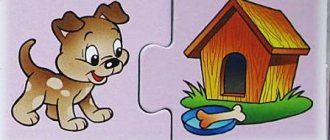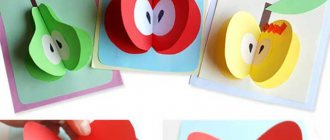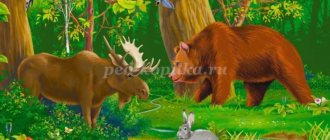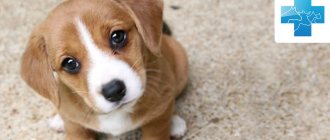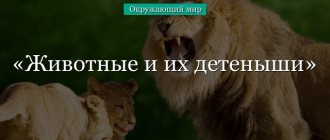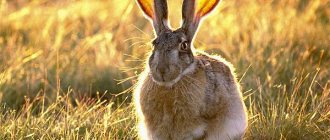Rules for using images
In order for the illustrative material to be truly useful when playing games, consider the following nuances:
- Choose pictures that correspond to the children's age level of development. For pupils under 3 years of age, images of only those animals that can be seen in urban and rural environments are suitable.
- The background should be white or any other light and solid color so as not to distract attention from the main object.
- To get to know the world around you, you cannot use cards that depict animals unrealistically. The appearance of the drawn object should be as close as possible to what the creature looks like in reality, including color. Do not use pictures of cartoon characters for educational games: they are beautiful, bright, but their appearance is distorted.
- Choose attractive images that are fun to play with. The colors should be rich, deep, and the contours should be clearly defined, and the parts of the animal’s body should be well drawn.
- To extend the life of printed pictures, glue them onto decorative cardboard and laminate them.
Reading in warehouses “Wild Animals” according to Zaitsev’s method
Reading by folds differs from reading by syllables, since folds divide the word into more parts. For example, in terms of syllables, the word “crocodile” - kro-ko-dil - has 3 syllables. And for warehouses k-ro-ko-di-l - 5 warehouses. Dividing a word into words when teaching reading is very effective, which is why Zaitsev’s method has been very popular all over the world for many years, without losing its relevance and usefulness over the years for teaching preschoolers and primary schoolchildren.
You can download warehouse cards “WILD ANIMALS” in the attachments at the bottom of the page
Types of pictures
To make it more convenient to work with the material, divide the pictures of animals into groups according to the presented image.
Plot
The cards depict not just animals, but a plot composition with their participation. The pictures are intended for making up stories; you can play educational and cognitive games with them. For example, study parts of speech and compose sentences from them. Or talk about topics relevant to the plot: why a person gets pets, where he puts them, what kind of food they provide.
Subject
These are simple pictures depicting a single animal. Subject cards can also be divided into categories:
- animals of our forests;
- Pets;
- fauna of the north;
- fauna of the south;
- birds;
- sea creatures, etc.
brain teaser
The pictures are combined into semantic groups. Children must figure out what the plot reveals and tell the resulting story.
For example, the first picture shows a gray hare, the second – a white one. The child says that the animal, in preparation for winter, sheds its summer coat in order to be invisible against the background of snow.
Coloring pages
When a child not only looks at, but also colors pictures of animals, this is additional help in speech development and improving finger motor skills. The little artist gets acquainted with new terms and a variety of colors. While coloring, you can play an educational game: study prepositions and adjectives.
Materials for children's activities
For classes in a kindergarten group, materials must be prepared in advance. For the application you will need:
- colored paper;
- glue;
- templates;
- scissors.
Templates depicting animal figures must be prepared in advance. For kids you need to choose simpler figures, for older groups - more complex ones.
Pictures of animals for children
The animal world is huge, but before entering school, a child should get acquainted with the most common representatives of the fauna of our planet. Studying is easier when you have beautiful color pictures in front of your eyes.
Wild
Not every city has zoos, and preschoolers do not always have the opportunity to watch television programs about nature. A great alternative is pictures of wild animals for children. Moreover, you don’t even have to print out the cards, but create a beautiful and interesting slide show, if technically possible. Tell us about each animal, where it lives, what it eats, and what makes it special.
Homemade
Not all children have the opportunity to go to their grandparents in the village in the summer to get to know the four-legged and winged inhabitants of the rural yard. If you live in a city, use pictures of pets for children. Tell us what benefits each pet brings, what sounds it makes, and how to care for it.
Baby animals
Children know what kittens, puppies, and chickens look like, but have no idea about the appearance of wild cubs. Use paired cards depicting an adult animal and its offspring.
Perhaps the child knows the names of many animals and birds, but has never heard the names of their babies. Tell him.
To develop intelligence and imagination, ask him to remember fairy tales and stories where animals with cubs are mentioned, come up with your own story together.
Pictures of animals of the north
The Arctic is a harsh region, but even there the fauna is quite diverse. The child will probably want to meet amazing northern creatures, some of which he is unlikely to see in reality, even in a zoo.
Animals of hot countries
The southern fauna is unusually rich and interesting. If necessary, pictures can be divided into groups:
- Africa;
- Australia;
- South America.
The child will certainly be interested in the unusual appearance of southern animals. Explain to him that the inhabitants of hot and arid areas are adapted to such a climate, their external features help them survive. For example, a camel has a hump or two on its back, where it stores fat, which it gradually uses up during long treks through the desert so as not to die from hunger and thirst. Or a leopard’s skin is covered with dark spots; this coloring makes it invisible among the dry African grass.
In general, the topic of southern fauna is very extensive and fascinating. Tell us why the giraffe has a long neck (to reach the acacia branches on which it feeds), why the elephant has large ears (to fan itself with them in the heat, for thermoregulation of the body), why the ostrich has large legs (it does not fly, but runs quickly) and much more.
Marine
It is not necessary to take your child to the aquarium to show the charm and richness of the underwater world. Explain to him that sea creatures are not like those that live on land. Dolphins and whales are mammals, but they have fins instead of paws, because they swim, not walk. Tell us about absolutely amazing creatures: starfish, urchins, skates, oysters with pearls.
Syllables for reading – Cards with pictures – Download and print
Before starting classes, ask if your child knows well which of the 12 animals are domestic and which are wild, where these animals live and what they eat. If you have already downloaded syllables for reading - cards with birds, mix a few pictures with birds with the animals and see if the child pays attention to it. Having previously cut the cards into pieces, ask the child to assemble each animal from these parts.
Start learning to read using cards, initially choosing pictures in which the names of animals are assembled from simple syllables consisting of only two sounds, gradually moving on to studying more complex ones, including hissing and voiceless consonants. When pronouncing how a particular syllable is read correctly, draw the child’s attention to its writing by running your finger over the syllable - this is necessary in order to simultaneously engage the baby’s visual and auditory perception.
Here you will find syllables for reading - Cards with the following animal names: squirrel, hippopotamus, hare, zebra, cow, kitten, crocodile, rhinoceros, fox, sheep, dog, turtle.
At the initial stage of learning, carefully monitor whether the child correctly repeats the pronunciation of syllables after you, correct if you hear that the child is making mistakes in order to prevent the formation of an erroneous understanding of sounds and syllables. Gradually complicate the tasks by giving all kinds of your own examples, or downloading additional cards with pictures and syllables.
You can download syllables for reading - Cards with animal names in pictures in the attachments at the bottom of the page
Always remember that your child should not be bored while learning: try to diversify your activities as much as possible, supplementing them with games, funny tasks, reading poetry, and mathematical calculations.
Reading by syllables “Animals”:
Educational games with cards
Pictures of animals are a wonderful tool for a variety of educational games:
- “What a wild animal...” . Ask the children who changes their coat for the winter, hibernates, lives in water, lives in trees, etc.
- “Who am I talking about?” . The presenter takes the cards one by one and, covering the image from the players, gives a description. Children must guess who we are talking about. The one who named it correctly takes the picture for himself. The winner is the one who collected the most cards.
- "Find the Cub" . Use paired cards (adult animals and their offspring), mix. The players' task is to find all mother and baby pairs.
- "Compare" . Show two pictures - a wild animal and a domestic animal. Children must tell how these creatures are similar and how they differ.
It’s not difficult to come up with educational games yourself: pictures of animals give room for imagination. They can be used not only in pedagogy, but also in speech therapy.
